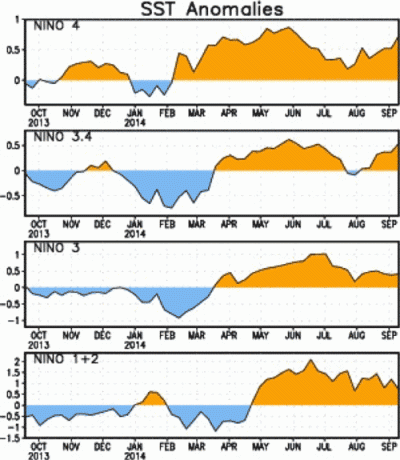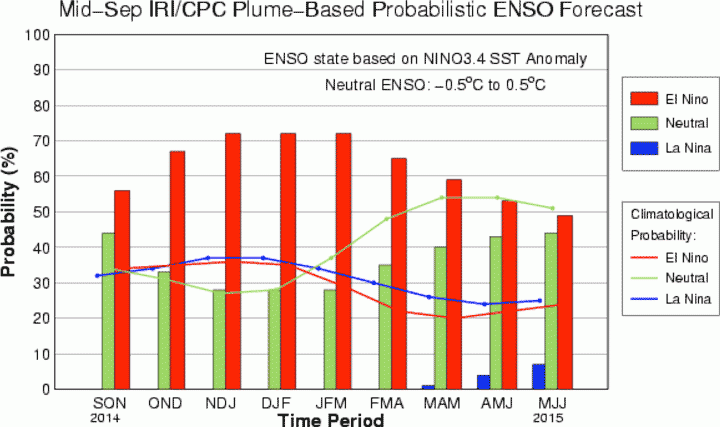News•September 18, 2014
El Niño is Kinda Sorta Maybe Here

By Brian Kahn
El Niño watchers, rejoice (maybe). A weak El Niño has formed (sorta).
On Tuesday, researchers at the International Research Institute for Climate and Society said a borderline El Niño is upon us, with the odds for further development increasing throughout the fall and winter.
Chart showing ocean temperatures in different regions of the Pacific used to gauge El Niño, including the recent rise in temperatures.
Credit: IRI

This El Niño has played a game of hide and seek since an El Niño Watch was declared way back in March. After picking up steam in the spring and early summer, El Niño conditions essentially disappeared in July and much of August.
But the telltale signs of El Niño are starting to re-emerge. Ocean temperatures in the tropical Pacific, which tend to warm during an El Niño, have reached the threshold last week typically used to declare El Niño has arrived.
“Borderline El Niño conditions have now returned in both ocean and atmosphere, after a 2-month hiatus,” said Tony Barnston, IRI’s chief forecaster.
And the running average of the Southern Oscillation Index, an atmospheric measure of El Niño, has also been hanging in El Niño territory for the past month according to Australia’s Bureau of Meteorology.
So why aren’t scientists shouting from the roofs that El Niño is here and ready to shift weather patterns around the globe?
“We would have to see temperatures at this level for about a month before we declare we have El Niño conditions,” said Dan Collins, a scientist with the Climate Prediction Center (CPC), in a separate call with reporters.RELATEDHow Will We Know When El Niño Finally Arrives?
El Niño Expected to Limit 2014 Hurricane Season
Why Do We Care So Much About El Niño?
Precipitation patterns over the tropical Pacific also haven’t quite lined up yet.
Barnston: “let's congratulate nature, we have a weak El Nino finally” #IRIforecast
— Elisabeth Gawthrop (@egawthrop) September 18, 2014
But El Niño-like impacts aren’t necessarily waiting for scientists to officially declare the climate phenomenon here. In fact, Collins said some impacts are already being seen in the U.S. Those include a decrease in hurricane activity in the Atlantic basin and an uptick in activity in the eastern Pacific, including tropical storms that have brought heavy rain to the Southwest recently. El Niño also tends to ramp up global temperatures, and according to numbers also released on Tuesday, this was the hottest summer ever recorded for the planet.
IRI’s forecast, which is issued in conjunction with CPC, shows the odds of El Niño fully developing and persisting from November-March are between 70-75 percent, up a few notches from their forecast issued earlier this month. Most models are still showing a weak-to-moderate event is likely. The main wrinkle that could put the kibosh on an El Niño is a shift in low level winds that could dissipate the warm surface waters. Barnston said that forecasters aren’t expecting that to happen, though.
A graph showing the likelihood of El Niño conditions over consecutive 3-month periods.
Credit: IRI

Asked for a corollary for such a late-blooming El Niño, Barnston said it resembled 1986.
“We had a late-developing El Niño in 1986, and that ended up becoming a moderate El Niño and lasted a second year because it couldn’t run its course in a seasonal time window like they usually do,” he said.
However, Barnston was quick to point out that if this El Niño forms, there’s no guarantee it would also be a multi-year event.
The other quirk to this year’s burgeoning El Niño is where the warmest waters are located. They currently sit in the central Pacific, a little west of where El Niño typical forms. If El Niño does form there, it would be a different flavor, known as El Niño Modoki. Some research has indicated that climate change could be upping the odds of Modoki – Japanese for similar but different – events.
But for now, researchers are focused on seeing if this El Niño finally comes out to play. And they'll have a better sense of that in two weeks when CPC and IRI release their official update.